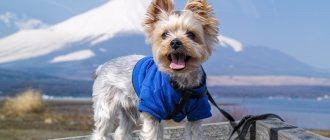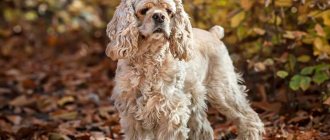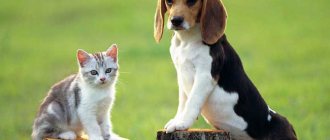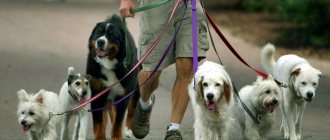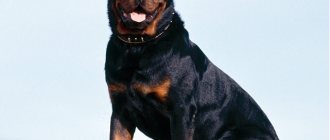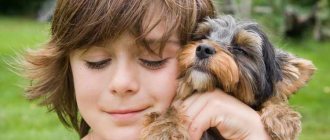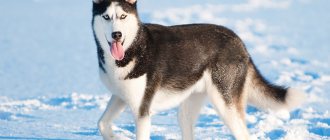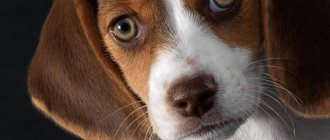A person who is a bundle of energy is constantly in a hurry somewhere, looking for adventure and involved in various social processes. However, there is another type of people, those who almost never stick their nose out into the street, preferring to while away the evenings in a cozy armchair. Fortunately, there are quite a few breeds of dogs for them that will not drag their owner out into the street. Instead, pets will curl up next to their owner and snore carefree. If you are a lazy person, then you need a smart dog.
Havanese
Another name for this breed is the Havanese Bichon. The weight of an adult does not exceed seven kilograms. They're pretty good to travel with (in case you decide to do more than walk from the couch to the refrigerator). And at the same time, the Havanese is extremely smart. He is the perfect human companion and will be happy to sit on his owner's lap all day.
Glen of Imaal Terrier
© CaptureLight/Getty Images
This dog is a type of working dog in Ireland, bred to hunt badgers and foxes. She needs:
Space is minimal.
This terrier weighs up to 35 pounds (approximately 16 kg) and fits well into an apartment environment.
Training is weak to moderate.
An intelligent and very easy to train dog, it gets along easily with other people and children, but can conflict with other dogs. She may also view other pets as toys, so she needs to be taught to treat them with respect.
Walking is a low need.
These terriers have very short legs compared to their body and are not really built for running, jumping or other strenuous activities. Short, infrequent walks will do them good without them asking you to walk them every day. They love to walk in places where there are fences, as these terriers are big fans of “digging.”
Care is low to moderate.
The coat grows by 2-3 cm, if you do not take care of it constantly, it does not shed often.
Pug
These cute puppies with their squashed faces and piggy tails have taken the world by storm. They are charming and smart and always know what they want. The dog will spend 99% of the time alone.
It's better to go well than to go poorly. A man helped a deer “swim across” the river: video
To the owner's roof: the dog learned to climb up a ladder (video)
Prevent falls: trainer showed 6 exercises for older people
French Bulldog
French bulldogs themselves are lazy and do not like exercise. Often, owners have to force their charges to go for a walk. Caring for representatives of the breed is relatively simple: a minimum of hygiene procedures, choosing a healthy diet and monitoring the well-being of the companion. The only drawback of bulldogs is their tendency to drool. Owners will have to clean more often.
A flattened muzzle puts dogs at increased risk for heart, lung and eye problems.
Bloodhound
A huge dog can weigh up to fifty kilograms. Perhaps due to its impressive dimensions, the Bloodhound exists in energy saving mode. His short, smooth coat does not require much grooming. These talented pups are known for their keen senses and passion for tracking. But they may well limit themselves to searching for a piece of cheese that accidentally fell from the master’s table.
Turned old jeans and copper pipes into a convenient shelf for books and magazines
What a beautiful view overhead: scientists have discovered a planet with three suns
Delicious pumpkin-shaped pies with two types of filling (and both are very juicy)
York
The Yorkie needs enhanced coat care and regular visits to the groomer. When washing, the owner should use mild shampoos and conditioners, and when combing, use a spray. This is compensated by its small size, the ability to train to a tray and its independent character. The Yorkie makes contact and loves to be the center of attention, but is able to entertain himself without the involvement of his owners. Representatives of the breed love games, but get tired quickly, so excessive physical activity is contraindicated for them.
Due to the structure of their hair, Yorkies practically do not shed.
Basset Hound
The Basset Hound breed is famous for its non-conflict and stupidity. Their short legs and large ears delight children. They love to communicate with other animals.
The 2nd century AD stone with a Greek inscription was for many years a step in the stables
I take two ingredients and make a universal household cleaner (no worse than store-bought)
I cut a piece of pork loin in several places and stuff it with tomatoes: recipe
Small breed dogs for apartments
A significant proportion of city residents choose these “pocket” options. After all, in terms of care requirements, they are not much different from a cat, they are less likely to cause discontent among neighbors, and in general they may not go outside for years. Miniature pinschers, spitzes and pugs do not require large expenditures on food, which also matters.
Chihuahua
These small dogs with huge eyes are the true leader among small breeds. And it’s not just about fashion: Chihuahuas are smaller in size even than cats, by nature they are quite lazy and do not require frequent games - they would rather lie on a soft pillow next to their owner. And short hair does not require frequent combing and struggle for cleanliness during the molting period.
Characteristics make the Chiahuahua the most “comfortable” dog for an apartment:
- They do not need constant communication with the owner, they easily tolerate their leaving for work;
- Independent and calm, like cats;
- Not prone to petty mischief;
- Loyal to the owner;
- They do not show a tendency to dominate and get along easily with children;
- But they can show aggression towards strangers and always defend their territory and their beloved owner.
If you like small breeds, then Chihuahuas are undoubtedly the best dogs for an apartment. Unpretentious to care for, loyal and unpretentious, they quickly become favorites of the whole family.
Miniature Pinscher
A representative of the hunting breed, slightly larger in size than the popular Chihuahua. At the withers, an adult dog reaches 21-30 cm, is always slender and fit, and looks like a miniature Doberman. This dog has a good combination of small size and character that every person dreams of:
- The Miniature Pinscher is a devoted friend, ready to protect you to the last drop of blood;
- He will support any undertaking from peacefully watching movies on the couch to rafting down a mountain river;
- Unpretentious in nutrition and care.
But this breed also has some unpleasant characteristics. Thus, the miniature pinscher does not have a special love for children and may bite if offended. Dogs of this breed do not tolerate loneliness well, so they often turn everything upside down. This is a dog for homebodies and freelancers.
Pug
Unlike the previous two breeds, the pug sincerely loves children. And they him too. Kids are delighted by the funny appearance and range of sounds made by the pug - sniffling, puffing and even snoring. If you are thinking about what kind of dog to get in your apartment so that it doesn’t cause any trouble at all, then this is your choice:
- Lazy by nature, pugs, even completely alone, will not tear your apartment to pieces. Most likely, they will snore peacefully all day;
- This is a great friend for children, able to tolerate any pranks;
- Smart and quick-witted, easy to train;
- Short hair is easy to care for;
- Does not require walking for many kilometers.
Among the disadvantages of pugs are only their low activity and tendency to obesity. The owner should also be prepared for food allergies, which these cute dogs often suffer from. Nutrition will have to be chosen more carefully than for other breeds.
Toy Terrier
When considering small dog breeds for an apartment, you should also pay attention to the Toy Terrier. Affectionate and sociable by nature, he is suitable for anyone looking for a loyal friend and companion. Toy gets along well with children, is calm and balanced, and is easy to train.
Initially, the miniature breed was bred for the purpose of hunting mice and rats. Perhaps this is why they differ little from cats in appearance and care. But training and education are required. In their absence, the dog is able to develop “star syndrome” and begin to consider itself the boss in the apartment - yapping at its owners, biting and acting eccentric.
Raising a toy terrier needs to be no less demanding and tough than a huge shepherd dog. Not ready for this? Look for another breed.
Dwarf Spitz
Fluffy Spitz dogs are ideal for aesthetic lovers who are ready to comb their pet’s thick coat every day. Otherwise, these dogs are perfect for an apartment:
- Unpretentious in care and nutrition;
- They are devoted to their owner and have moderate sociability - they will not constantly hover under your feet;
- They are friendly and get along well with children;
- They can easily tolerate being around cats and other animals;
- They do not like long walks and are ready to limit themselves to a tray.
All Spitz dogs are good for apartments - dwarf, German, and Japanese. They are great for retirees and lazy freelancers: they don’t need long walks, but they are ready to become a companion in any business.
Irish Wolfhound
These stately greyhounds, bred in Ireland, proudly hold the title of the tallest dog breed. Despite their solid appearance, puppies love to play with children, are graceful and patient.
3 things you shouldn’t tell anyone, even those who don’t wish you harm
A hawk threatens a duck, but it doesn't care: funny video
Cooking tiramisu roll without baking and eggs: a simple recipe
Toy Terrier
Record holder for unpretentiousness. Toy terriers have short hair, do not require a visit to the groomer and patiently tolerate hygiene procedures.
The dog does not need daily walking. You can accustom her to a diaper or litter box, but you will still have to go outside at least 2-3 times a week. This is necessary for emotional release and proper social adaptation of the dog. A friend of mine bought a toy terrier precisely because there was no need for walking. She did not take him outside; as a result, the dog became exclusively an apartment dog. The pet has a weak psyche: he is afraid of everything and behaves too actively when he sees other dogs. This is all due to the fact that the pet did not acquire the necessary experience and did not learn to react correctly to others.
Toy Terriers rarely have ear problems due to their shape and good ventilation.
The disadvantages include the overly active and hot-tempered temperament of most representatives of the breed. However, there are exceptions: with an initially calm character and proper upbringing, the dog will grow up docile.
Saint Bernard
They are best known for their alpine rescues, but these days you are much more likely to find St Bernards in the suburbs than in the Swiss Alps. Their calm and patient nature also makes these gentle giants an excellent "nanny dog" for children.
Buy a Saint Bernard puppy
German dog
You can even look forward to regular walks with a stately dog at the other end of the leash. Unlike some other large breeds, Great Danes make friends easily and remain patient even with (much smaller) kids.
Buy a Great Dane puppy
Chow chow
Don't mistake their signature frowns for a bad attitude. Although Chow Chows are somewhat stubborn and suspicious of strangers, they are loyal and attached to their families. Their reserved and quiet nature is in fact often compared to cats.
Buy a chow chow puppy
Newfoundland
Weighing up to 150 pounds, Newfoundlands require a little space and regular romp, but otherwise maintain a pleasant and docile disposition. The best way to get these puppies used to exercise is to take them near water. They are natural swimmers!
Buy a Newfoundland puppy
Shih Tzu
They've been friendly pets for hundreds of years, so it's no surprise that Shih Tzus don't require much grooming—except for their long coats. Some owners prefer a shorter haircut for this reason.
Buy a Shih Tzu puppy
Keeping dogs at home
You have decided on the breed, made an appointment with the breeder and finally taken your beloved pet home. Perhaps your four-legged friend accidentally met on the street on the way home.
It doesn’t matter what happened “before” - now the main task is to organize your own corner for the newly-made family member and get to know the rules of behavior in your home.
The tips given in the article are universally applicable to all dogs, but do not forget to familiarize yourself with the behavior and maintenance of a particular breed.
We present to you the basics of keeping puppies and adult dogs at home. Contents
hide
- 1. Personal space
- 2. Home toilet
- 3. Nutrition 3.1. Video: Check yourself to see if you are feeding your dog correctly. Myths about dog food.
Personal space
A dog, like any family member, should have its own corner in which it can rest and sleep. It should be marked with soft bedding, a small mattress, a basket with a thin pillow or a comfortable rug; it is recommended to place the dog’s favorite toys nearby.
You should choose a place away from heating appliances and doors to avoid overheating and drafts. If it is a mattress or a multi-layer blanket, then it is advisable to build a cover for it.
The bedding or cover is washed every 2-3 weeks to avoid the accumulation of bacteria. Keep your pet's area dry and clean at all times.
Home toilet
It is recommended to walk dogs at the same time in order to quickly become accustomed to the toilet and eating. To organize a litter box at home, explore various devices, taking into account the size and needs of your pet.
The most popular are:
- box toilets;
- trays with diapers, lawn grass;
- Pillar toilets.
A home toilet will solve problems on days when there is no time to walk with your pet, the dog is on sick leave or a routine vaccination has been carried out and going outside is impossible.
To train your dog to a certain place:
- place a cloth with your pet’s urine in the tray;
- if you catch a dog defecating in the wrong place, take it to the tray (the place itself must be treated with a special “repellent” agent);
- do not forget to praise and scold your pet using the appropriate intonation.
Nutrition
Regardless of whether you feed your dog the traditional way or ready-made food for meals, you need to equip a separate place. Usually two bowls are purchased: for water and main food. They should be placed in a place that is easy to clean up after feeding.
In no case should it be located near outer clothing, from which dust and dirt can get into the feed, and also be located on a fleecy surface that is difficult to clean. You can place a rubber mat or oilcloth under the bowls. The most logical place to organize a feeding place is in the kitchen.
The container must have the following volume:
- for puppies and small breed dogs - up to 400 ml;
- for older puppies and medium-sized dogs - from 700 ml to 2 l;
- for large dogs do not exceed 2-2.5 liters.
Bowls can be made of plastic, ceramic and metal. Due to the playfulness of the first option, the dog can easily turn it over and the eating area will always be in disarray; a ceramic bowl breaks easily if it is placed on a stand; a metal bowl is a universal option, since it is stable and easy to use.
It is necessary to wash bowls with laundry soap, as any remaining dishwashing detergent can cause an allergic reaction in the dog.
It is recommended to set aside a certain time for feeding your pet, after which the dishes and food are removed. In this way, you can determine the required amount of food to satiate, avoid overeating and obesity, as well as playing with the food remaining in the bowl.
Video: Check yourself to see if you are feeding your dog correctly. Myths about dog food.
Home first aid kit
Every day, inspect the folds on the dog's body, check the paws, fur, eyes, ears and nose for any abnormalities. These simple procedures will help you notice the first signs of certain diseases in time.
Your pet's first aid kit must include:
- wound healing drugs (for example, ebermin, bepanten-plus, D-panthenol)
- antiseptic (sodium chloride 0.9%, miramistin 0.01% or chlorhexidine 0.05%)
- sorbent in case of dog poisoning (for example, activated carbon, enterosgel, polysorb)
- laxatives such as Duphalac or flaxseed oil
- antibiotic eye drops (tsiprolet/tsipromed), tobrex)
- lotions for treating eyes, ears and toothpaste (can be found in specialized veterinary pharmacies).
The materials must include:
- bandages;
- cotton pads;
- antibacterial wipes;
- tweezers;
- tourniquets;
- scissors.
From the first day a dog arrives in your home, be sure to consult with a veterinarian regarding the use of certain medications, since your pet may have an individual intolerance or an allergic reaction to some of them.
Afterwards, do not forget to regularly conduct a comprehensive examination. If necessary, the doctor will prescribe medications or select appropriate care taking into account the pet’s health, age, size and characteristics.
If you plan to travel with a dog, take care of a travel veterinary first aid kit, which will also contain all the necessary first aid supplies and write down the contacts of veterinary clinics near your place of stay.
Dog walking
When going for a walk, make sure you have a collar, leash, muzzle, favorite toy, treats, dustpan and bag for cleaning up after your dog. If your pet is on the street for the first time or you are walking in a new place for him, then hold the dog in your arms.
Walk around the area for a few minutes and gently, without letting go of the leash, lower it to the ground.
At first, in order to teach your dog to go to the toilet outside, you will have to walk very often. Later, you can set a specific time at which your pet needs to relieve itself. Make sure your dog doesn't try to eat anything or drink from a dirty puddle.
During your walk, spend most of your time doing the following activities:
- play with the animal or train it
- let them play with other dogs that have an owner nearby.
Find a designated dog walking area where you can remove the muzzle and unfasten the leash so your dog can run around to his heart's content. These places do not include city parks, playgrounds, school stadiums and regular sidewalks.
On the back of the collar you need to sign with the dog's name and your contact phone number. This information can also be engraved on a tag and attached to the collar.
Such measures will help you quickly find your dog if it suddenly gets off the leash, runs away and gets lost. For the same reason, the collar can only be removed at home.
Greyhound or English Greyhound
The Greyhound is a gentle dog who prefers to stretch out by the fire next to his owner and family, but he has a more active purpose. English greyhounds have an aerodynamic body shape, a narrow head, and long and muscular legs. The dog's physique is due to the fact that it is a hunting breed. Now this breed participates in dog racing. In fact, when you mention a greyhound to another person, the first thing that comes to mind is the dog racing track. Capable of reaching speeds of 40 to 45 miles per hour, the Greyhound is considered the Ferrari of dogs.
Greyhounds excel in a variety of competitions such as competition, conformation, lure trials, and training. The dog is non-aggressive and friendly, although it may keep aloof from strangers. Abuse of a Greyhound will cause it to become timid or shy. Proper training and socialization will give you a dog that is playful and curious. In addition, you have the opportunity to adopt a puppy or an adult dog who has finished his racing career.
